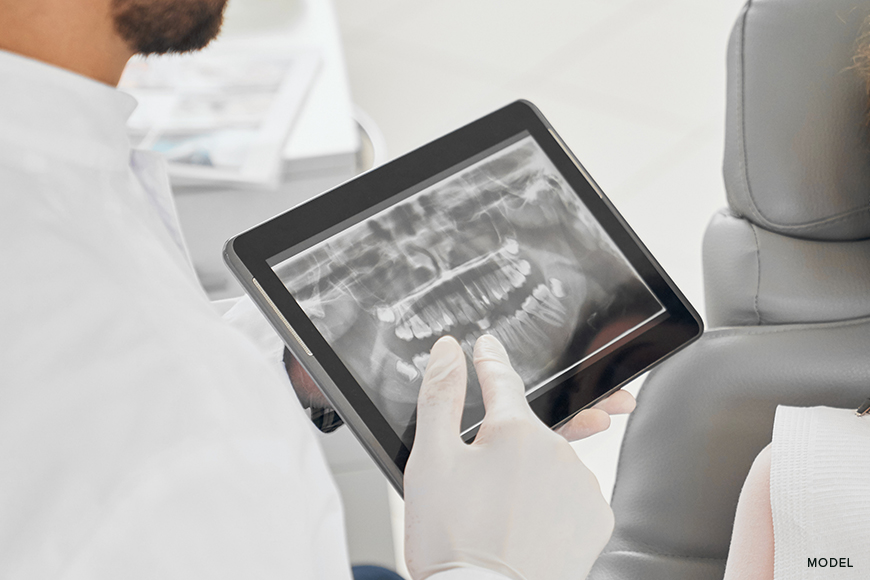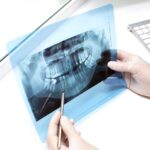Dental X-rays, also known as radiographs, are essential diagnostic tools used by dentists to visualize the hidden structures within your mouth to detect and diagnose various dental conditions that may not be visible during a regular oral examination. In the upcoming discussion, we will delve more deeply into the significance and types of dental X-rays.
Types of Dental X-Rays
Dental X-rays are an integral part of preventive and restorative dental care. They help in:
- Identifying cavities and tooth decay
- Assessing the health of tooth roots
- Evaluating the condition of the jawbone
- Detecting cysts, tumors, or abscesses
- Planning orthodontic treatments
- Monitoring oral health over time
Intraoral X-Rays
Intraoral X-rays are a category of dental radiographs that focus on capturing detailed images of the inside of the mouth. These X-rays are taken with the film or sensor placed inside the patient’s mouth, providing close-up views of individual teeth and their surrounding structures. Intraoral X-rays are commonly used to assess tooth decay, gum health, and the condition of dental restorations, ultimately aiding in the diagnosis and treatment planning for various dental concerns.
- Bitewing X-Rays
Bitewing X-rays are commonly used to detect cavities and assess the fit of dental restorations. They are named ‘bitewing’ because the patient bites down on a small piece of film while the X-ray is taken. - Periapical X-Rays
Periapical X-rays focus on individual teeth, capturing the entire tooth from crown to root. They are useful for diagnosing dental infections and assessing the condition of the tooth’s supporting structures. - Occlusal X-Rays
Occlusal X-rays provide a broad view of the entire arch of teeth in the upper or lower jaw. They help in identifying issues like extra teeth, cysts, or jaw fractures.
Extraoral X-Rays
Extraoral X-Rays are dental radiographs taken from outside the mouth. These X-rays provide a broader view of the oral and facial structures. They are particularly valuable for evaluating the jaw, skull, and other larger areas of the head and neck. Extraoral X-rays are often used to diagnose issues such as impacted wisdom teeth, jaw fractures, and abnormalities in the entire oral region.
- Panoramic X-Rays
Panoramic X-rays provide a panoramic view of the entire mouth. They are particularly useful for assessing wisdom teeth, jaw problems, and identifying tumors or abnormalities. - Cephalometric X-Rays
Cephalometric X-rays focus on capturing the side profile of the head and neck. These types of dental X-rays are vital in orthodontic treatment planning. - Cone Beam Computed Tomography (CBCT)
CBCT is a sophisticated imaging technique that produces 3D images of the teeth and jawbone. It is invaluable for complex dental procedures like dental implant placement.
Common Uses and Benefits of Dental X-Rays
Dental X-rays are utilized for various purposes, including diagnosing cavities, evaluating the extent of gum disease, and assessing the condition of existing dental restorations. It offers numerous benefits, such as early detection of dental issues, precise treatment planning, and the ability to monitor changes in oral health over time. Additionally, dental X-rays can help dentists identify developmental abnormalities in children’s teeth and jaw bones.
Madison Dentistry & Implant Center: Your Trusted Provider
In conclusion, dental X-rays are indispensable tools in modern dentistry. They help dentists diagnose and treat various dental conditions effectively. Understanding the different types of dental X-rays and their applications can empower patients to take charge of their oral health inclusively.
When it comes to your oral health, trust the experts at Madison Dentistry & Implant Center to offer comprehensive types of dental X-rays service using state-of-the-art equipment and ensure your safety throughout the procedure.
Contact us today to schedule your X-ray appointment and take the first step towards a healthy, radiant smile with us.




